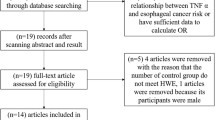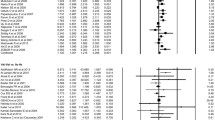Abstract
Several molecular epidemiological studies were conducted in recent years to evaluate the association between NQO1 Pro187Ser polymorphism and breast cancer risk in diverse populations. However, the results remain conflicting rather than conclusive. This meta-analysis on 3177 cases with breast cancer and 4038 controls from seven published case–control studies showed that the 187Ser allele was not associated with a significantly increased risk of breast cancer (Ser versus Pro: P = 0.33, OR = 1.08, 95% CI = 0.92–1.28; Ser/Ser versus Pro/Pro: P = 0.58, OR = 1.16, 95% CI = 0.68–2.00; Ser/Ser versus Pro/Ser + Pro/Pro: P = 0.62, OR = 1.14, 95% CI = 0.68–1.90; Ser/Ser + Pro/Ser versus Pro/Pro: P = 0.30, OR = 1.07, 95% CI = 0.94–1.22). In the stratified analysis by ethnicity, we found that the Pro187Ser polymorphism was associated with increased breast cancer risk in Caucasians in the additive genetic model and dominant genetic model (P = 0.03, OR = 1.13, 95% CI = 1.01–1.26; P = 0.03, OR = 1.15, 95% CI = 1.01–1.30, respectively), whereas no significant in Asians (P = 0.44, OR = 0.94, 95% CI = 0.80–1.10) and postmenopausal women (P = 0.99, OR = 1.00, 95% CI = 0.84–1.19). The results suggest that NQO1 Pro187Ser polymorphism may contribute to breast cancer development in Caucasians.


Similar content being viewed by others
References
Hong CC, Ambrosone CB, Ahn J, Choi JY, McCullough ML, Stevens VL, Rodriguez C, Thun MJ, Calle EE (2007) Genetic variability in iron-related oxidative stress pathways (Nrf2, NQ01, NOS3, and HO-1), iron intake, and risk of postmenopausal breast cancer. Cancer Epidemiol Biomarkers Prev 16:1784–1794
Cai Q, Shu XO, Wen W, Cheng JR, Dai Q, Gao YT, Zheng W (2004) Genetic polymorphism in the manganese superoxide dismutase gene, antioxidant intake, and breast cancer risk: results from the Shanghai Breast Cancer Study. Breast Cancer Res 6:R647–R655
Tamimi RM, Hankinson SE, Spiegelman D, Colditz GA, Hunter DJ (2004) Manganese superoxide dismutase polymorphism, plasma antioxidants, cigarette smoking, and risk of breast cancer. Cancer Epidemiol Biomarkers Prev 13:989–996
Siegel D, Gustafson DL, Dehn DL, Han JY, Boonchoong P, Berliner LJ, Ross D (2004) NAD(P)H:quinone oxidoreductase 1: role as a superoxide scavenger. Mol Pharmacol 65:1238–1247
Beyer RE, Segura-Aguilar J, Di Bernardo S, Cavazzoni M, Fato R, Fiorentini D, Galli MC, Setti M, Landi L, Lenaz G (1996) The role of DT-diaphorase in the maintenance of the reduced antioxidant form of coenzyme Q in membrane systems. Proc Natl Acad Sci USA 93:2528–2532
Siegel D, Bolton EM, Burr JA, Liebler DC, Ross D (1997) The reduction of alpha-tocopherolquinone by human NAD(P)H: quinone oxidoreductase: the role of alpha-tocopherolhydroquinone as a cellular antioxidant. Mol Pharmacol 52:300–305
Winski SL, Swann E, Hargreaves RH, Dehn DL, Butler J, Moody CJ, Ross D (2001) Relationship between NAD(P)H:quinone oxidoreductase 1 (NQO1) levels in a series of stably transfected cell lines and susceptibility to antitumor quinones. Biochem Pharmacol 61:1509–1516
Tseng LM, Yin PH, Tsai YF, Chi CW, Wu CW, Lee LM, Lee HC (2009) Association between mitochondrial DNA 4, 977 bp deletion and NAD(P)H:quinone oxidoreductase 1 C609T polymorphism in human breast tissues. Oncol Rep 21:1169–1174
Anwar A, Dehn D, Siegel D, Kepa JK, Tang LJ, Pietenpol JA, Ross D (2003) Interaction of human NAD(P)H:quinone oxidoreductase 1 (NQO1) with the tumor suppressor protein p53 in cells and cell-free systems. J Biol Chem 278:10368–10373
Asher G, Lotem J, Cohen B, Sachs L, Shaul Y (2001) Regulation of p53 stability and p53-dependent apoptosis by NADH quinone oxidoreductase 1. Proc Natl Acad Sci USA 98:1188–1193
Asher G, Lotem J, Kama R, Sachs L, Shaul Y (2002) NQO1 stabilizes p53 through a distinct pathway. Proc Natl Acad Sci USA 99:3099–3104
Asher G, Lotem J, Sachs L, Kahana C, Shaul Y (2002) Mdm-2 and ubiquitin-independent p53 proteasomal degradation regulated by NQO1. Proc Natl Acad Sci USA 99:13125–13130
Iskander K, Gaikwad A, Paquet M, Long DJ 2nd, Brayton C, Barrios R, Jaiswal AK (2005) Lower induction of p53 and decreased apoptosis in NQO1-null mice lead to increased sensitivity to chemical-induced skin carcinogenesis. Cancer Res 65:2054–2058
Long DJ II, Waikel RL, Wang XJ, Perlaky L, Roop DR, Jaiswal AK (2000) NAD(P)H:quinone oxidoreductase 1 deficiency increases susceptibility to benzo(a)pyrene-induced mouse skin carcinogenesis. Cancer Res 60:5913–5915
Ahn KS, Sethi G, Jain AK, Jaiswal AK, Aggarwal BB (2006) Genetic deletion of NAD(P)H:quinone oxidoreductase 1 abrogates activation of nuclear factor-kappaB, IkappaBalpha kinase, c-Jun N-terminal kinase, Akt, p38, and p44/42 mitogen-activated protein kinases and potentiates apoptosis. J Biol Chem 281:19798–19808
Nebert DW, Roe AL, Vandale SE, Bingham E, Oakley GG (2002) NAD(P)H:quinone oxidoreductase (NQO1) polymorphism, exposure to benzene, and predisposition to disease: a HuGE review. Genet Med 4:62–70
Kuehl BL, Paterson JW, Peacock JW, Paterson MC, Rauth AM (1995) Presence of a heterozygous substitution and its relationship to DT-diaphorase activity. Br J Cancer 72:555–561
Siegel D, Anwar A, Winski SL, Kepa JK, Zolman KL, Ross D (2001) Rapid polyubiquitination and proteasomal degradation of a mutant form of NAD(P)H:quinone oxidoreductase 1. Mol Pharmacol 59:263–268
Siegel D, McGuinness SM, Winski SL, Ross D (1999) Genotype–phenotype relationships in studies of a polymorphism in NAD(P)H:quinone oxidoreductase 1. Pharmacogenetics 9:113–121
Fowke JH, Shu XO, Dai Q, Jin F, Cai Q, Gao YT, Zheng W (2004) Oral contraceptive use and breast cancer risk: modification by NAD(P)H:quinone oxoreductase (NQO1) genetic polymorphisms. Cancer Epidemiol Biomarkers Prev 13:1308–1315
Menzel HJ, Sarmanova J, Soucek P, Berberich R, Grunewald K, Haun M, Kraft HG (2004) Association of NQO1 polymorphism with spontaneous breast cancer in two independent populations. Br J Cancer 90:1989–1994
Sarmanova J, Susova S, Gut I, Mrhalova M, Kodet R, Adamek J, Roth Z, Soucek P (2004) Breast cancer: role of polymorphisms in biotransformation enzymes. Eur J Hum Genet 12:848–854
Fagerholm R, Hofstetter B, Tommiska J, Aaltonen K, Vrtel R, Syrjakoski K, Kallioniemi A, Kilpivaara O, Mannermaa A, Kosma VM et al (2008) NAD(P)H:quinone oxidoreductase 1 NQO1*2 genotype (P187S) is a strong prognostic and predictive factor in breast cancer. Nat Genet 40:844–853
Lin PP, Hsueh YM, Ko JL, Liang YF, Tsai KJ, Chen CY (2003) Analysis of NQO1, GSTP1, and MnSOD genetic polymorphisms on lung cancer risk in Taiwan. Lung Cancer 40:123–129
Rosvold EA, McGlynn KA, Lustbader ED, Buetow KH (1995) Identification of an NAD(P)H:quinone oxidoreductase polymorphism and its association with lung cancer and smoking. Pharmacogenetics 5:199–206
Hamajima N, Matsuo K, Iwata H, Shinoda M, Yamamura Y, Kato T, Hatooka S, Mitsudomi T, Suyama M, Kagami Y et al (2002) NAD(P)H: quinone oxidoreductase 1 (NQO1) C609T polymorphism and the risk of eight cancers for Japanese. Int J Clin Oncol 7:103–108
Hung RJ, Boffetta P, Brennan P, Malaveille C, Gelatti U, Placidi D, Carta A, Hautefeuille A, Porru S (2004) Genetic polymorphisms of MPO, COMT, MnSOD, NQO1, interactions with environmental exposures and bladder cancer risk. Carcinogenesis 25:973–978
Vineis P, Veglia F, Garte S, Malaveille C, Matullo G, Dunning A, Peluso M, Airoldi L, Overvad K, Raaschou-Nielsen O et al (2007) Genetic susceptibility according to three metabolic pathways in cancers of the lung and bladder and in myeloid leukemias in nonsmokers. Ann Oncol 18:1230–1242
Aston CE, Ralph DA, Lalo DP, Manjeshwar S, Gramling BA, DeFreese DC, West AD, Branam DE, Thompson LF, Craft MA et al (2005) Oligogenic combinations associated with breast cancer risk in women under 53 years of age. Hum Genet 116:208–221
Siegelmann-Danieli N, Buetow KH (2002) Significance S-transferase M1 and NAD(P)H: quinone oxidoreductase 1 detoxification genes in breast cancer development. Oncology 62:39–45
Begg CB, Mazumdar M (1994) Operating characteristics of a rank correlation test for publication bias. Biometrics 50:1088–1101
Egger M, Davey Smith G, Schneider M, Minder C (1997) Bias in meta-analysis detected by a simple, graphical test. BMJ 315:629–634
Li H, Hao X, Zhang W, Wei Q, Chen K (2008) The hOGG1 Ser326Cys polymorphism and lung cancer risk: a meta-analysis. Cancer Epidemiol Biomarkers Prev 17:1739–1745
Chao C, Zhang ZF, Berthiller J, Boffetta P, Hashibe M (2006) NAD(P)H:quinone oxidoreductase 1 (NQO1) Pro187Ser polymorphism and the risk of lung, bladder, and colorectal cancers: a meta-analysis. Cancer Epidemiol Biomarkers Prev 15:979–987
Acknowledgments
All authors read and approved the final article. We are grateful to the members of the Institute of Cancer Prevention and Treatment of Harbin Medical University for supporting our study. We also thank Professor Tseng LM, from the Department of Surgery, Taipei Veterans General Hospital and National Yang-Ming University for kind help.
Competing interests
The author(s) declare that they have no competing interests.
Author information
Authors and Affiliations
Corresponding authors
Additional information
Weiguang Yuan and Lidan Xu contributed equally to this work.
Rights and permissions
About this article
Cite this article
Yuan, W., Xu, L., Chen, W. et al. Evidence on the association between NQO1 Pro187Ser polymorphism and breast cancer risk in the current studies: a meta-analysis. Breast Cancer Res Treat 125, 467–472 (2011). https://doi.org/10.1007/s10549-010-0966-0
Received:
Accepted:
Published:
Issue Date:
DOI: https://doi.org/10.1007/s10549-010-0966-0




